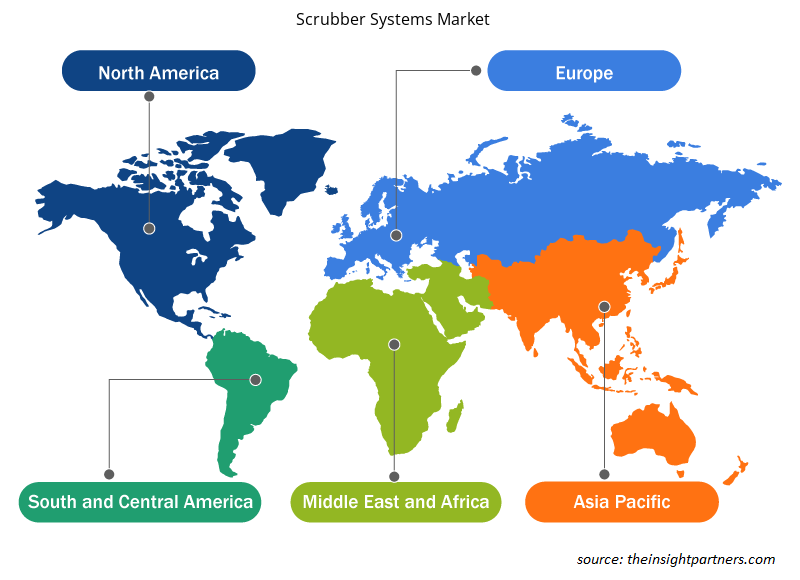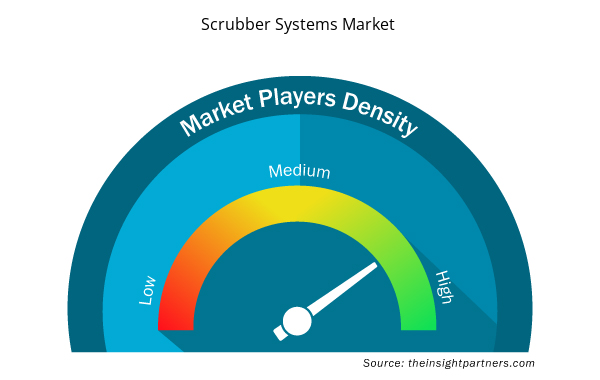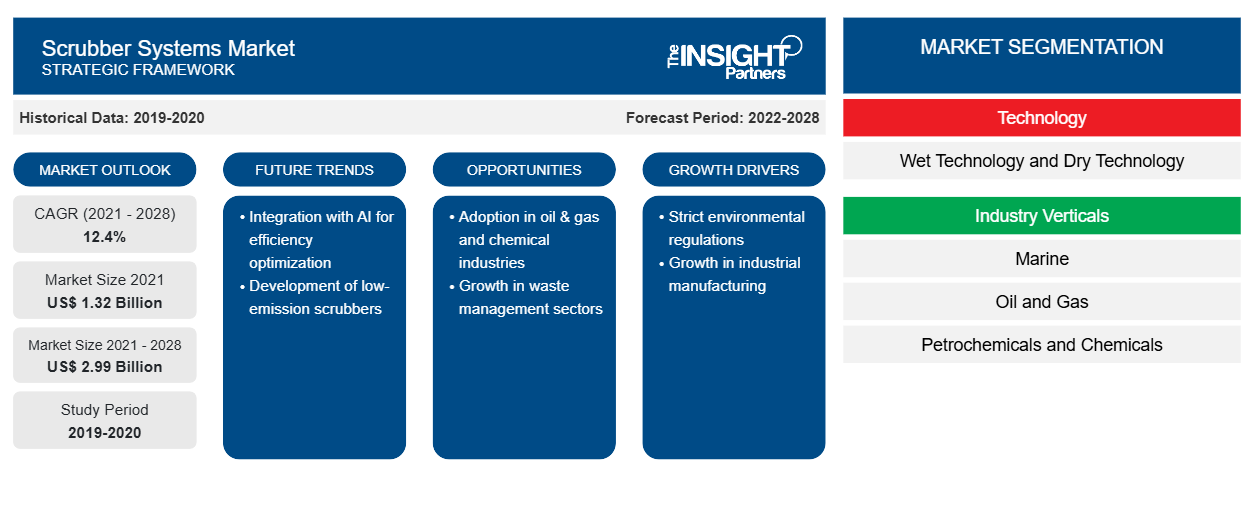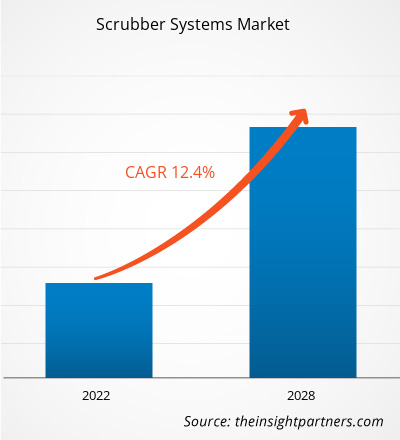Le marché des systèmes d'épuration a été évalué à 1 316,0 millions USD en 2021 et devrait atteindre 2 989,2 millions USD d'ici 2028 ; il devrait croître à un TCAC de 12,4 % de 2021 à 2028.
Les principales industries manufacturières telles que le ciment, le verre, les produits chimiques et pétrochimiques, l'alimentation et l'agriculture et les produits pharmaceutiques sont connues pour leurs émissions de gaz nocifs. Par conséquent, les réglementations environnementales strictes imposées à ces industries stimulent le marché. Par exemple, l'industrie du ciment est l'une des principales industries polluantes car elle libère des particules de dioxyde d'azote (NO2) et de dioxyde de soufre (SO2) pendant la production. De plus, l'augmentation des échanges internationaux par voie maritime et l'augmentation des activités de loisirs propulsent la croissance du marché des systèmes d'épuration . L'augmentation du commerce maritime mondial peut être attribuée à son coût de transport économique et à la demande mondiale en constante augmentation de biens et de produits pétroliers. En outre, la participation croissante aux activités de loisirs telles que les croisières et les voyages internationaux stimule l'utilisation des navires et alimente par la suite la croissance du marché des systèmes d'épuration.
Impact de la pandémie de COVID-19 sur le marché des systèmes d'épuration
L'épidémie soudaine de COVID-19 a eu un impact négatif important sur la demande du secteur des systèmes d'épuration à la suite de la pandémie mondiale. En août 2020, Yara Marine Technologies, l'un des principaux acteurs du secteur des épurateurs marins, a détourné son attention du marché en raison de la COVID-19 et des bas prix du pétrole. Le responsable de l'innovation de l'entreprise a déclaré qu'elle avait de grands espoirs en 2020 pour les systèmes d'épuration, mais que la COVID-19 a tout changé. Cependant, le marché a connu une augmentation de la demande à partir du troisième trimestre, plusieurs gouvernements ayant introduit des réglementations strictes pour maintenir l'air pur. Les systèmes d'épuration d'air jouent un rôle essentiel dans l'élimination des particules dangereuses des gaz d'échappement, aidant ainsi le marché à reprendre son élan.
Personnalisez ce rapport en fonction de vos besoins
Vous bénéficierez d'une personnalisation gratuite de n'importe quel rapport, y compris de certaines parties de ce rapport, d'une analyse au niveau des pays, d'un pack de données Excel, ainsi que de superbes offres et réductions pour les start-ups et les universités.
- Obtenez les principales tendances clés du marché de ce rapport.Cet échantillon GRATUIT comprendra une analyse de données, allant des tendances du marché aux estimations et prévisions.
Informations sur le marché –
Marché des systèmes de lavage
Augmentation du commerce maritime mondial et des activités de loisirs
L'augmentation du commerce international par voie maritime et l'augmentation des activités de loisirs stimulent la croissance du marché des systèmes d'épuration. L'augmentation du commerce maritime mondial peut être attribuée à son coût de transport économique et à la demande mondiale en constante augmentation de biens et de produits pétroliers. En outre, la participation croissante aux activités de loisirs telles que les vacances en croisière et les voyages internationaux augmente l'utilisation des navires et alimente par la suite la croissance du marché des systèmes d'épuration. L'augmentation des activités de loisirs peut être attribuée à l'augmentation du revenu par habitant des consommateurs. Par conséquent, l'augmentation des émissions de soufre des navires, en raison de l'essor du commerce mondial, et l'intensification du transport maritime dans les économies en développement et développées stimulent les installations de systèmes d'épuration.
Informations basées sur la technologie
Sur la base de la technologie, le marché des systèmes d'épuration est segmenté en technologie humide et technologie sèche. Le segment de la technologie humide détenait une part de marché plus importante en 2021.
Les acteurs opérant sur le marché des systèmes d’épurateur se concentrent principalement sur le développement de produits avancés et efficaces.
- En juillet 2021, Babcock & Wilcox Environmental a annoncé qu'il soutiendrait la demande d'Amager Resource Center pour la construction d'une installation avancée de capture du dioxyde de carbone dans l'usine de valorisation énergétique des déchets d'Amager-Bakke (Copenhill) d'ARC à Copenhague, au Danemark, pour plus de 140 millions de dollars américains.
- En septembre 2021, DuPont Clean Technologies a présenté une solution innovante et avancée de suppression du panache de vapeur pour ses épurateurs MECS DynaWave dans les applications d'unités de récupération du soufre (SRU). Sennuba offre un contrôle fiable de la corrosion et une suppression du panache dans le système d'épuration qui présente un risque minimal de colmatage.
Aperçu régional du marché des systèmes de lavage
Les tendances régionales et les facteurs influençant le marché des systèmes de lavage tout au long de la période de prévision ont été expliqués en détail par les analystes d’Insight Partners. Cette section traite également des segments et de la géographie du marché des systèmes de lavage en Amérique du Nord, en Europe, en Asie-Pacifique, au Moyen-Orient et en Afrique, ainsi qu’en Amérique du Sud et en Amérique centrale.

- Obtenez les données régionales spécifiques au marché des systèmes d'épuration
Portée du rapport sur le marché des systèmes d'épuration
| Attribut de rapport | Détails |
|---|---|
| Taille du marché en 2021 | 1,32 milliard de dollars américains |
| Taille du marché d'ici 2028 | 2,99 milliards de dollars américains |
| Taux de croissance annuel moyen mondial (2021-2028) | 12,4% |
| Données historiques | 2019-2020 |
| Période de prévision | 2022-2028 |
| Segments couverts | Par technologie
|
| Régions et pays couverts | Amérique du Nord
|
| Leaders du marché et profils d'entreprises clés |
|
Densité des acteurs du marché des systèmes de lavage : comprendre son impact sur la dynamique commerciale
Le marché des systèmes d'épuration connaît une croissance rapide, tirée par la demande croissante des utilisateurs finaux en raison de facteurs tels que l'évolution des préférences des consommateurs, les avancées technologiques et une plus grande sensibilisation aux avantages du produit. À mesure que la demande augmente, les entreprises élargissent leurs offres, innovent pour répondre aux besoins des consommateurs et capitalisent sur les tendances émergentes, ce qui alimente davantage la croissance du marché.
La densité des acteurs du marché fait référence à la répartition des entreprises ou des sociétés opérant sur un marché ou un secteur particulier. Elle indique le nombre de concurrents (acteurs du marché) présents sur un marché donné par rapport à sa taille ou à sa valeur marchande totale.
Les principales entreprises opérant sur le marché des systèmes d'épuration sont :
- Entreprises Babcock & Wilcox, Inc.
- Alfa Laval
- DuPont de Nemours, Inc.
- FUJI ÉLECTRIQUE CO., LTD.
- Groupe GEA SA
Avis de non-responsabilité : les sociétés répertoriées ci-dessus ne sont pas classées dans un ordre particulier.

- Obtenez un aperçu des principaux acteurs du marché des systèmes de lavage
Le marché des systèmes d’épuration a été segmenté comme suit :
Marché des systèmes de lavage – par technologie
Marché des systèmes de lavage – par secteurs d’activité
- Marin
- Pétrole et gaz
- Produits pétrochimiques et chimiques
- Alimentation et agriculture
- Traitement des eaux usées
- Soins de santé
- Autres
Marché des systèmes de lavage – par géographie
- Amérique du Nord
- NOUS
- Canada
- Mexique
- Europe
- Allemagne
- France
- Italie
- ROYAUME-UNI
- Russie
- Reste de l'Europe
- Asie-Pacifique (APAC)
- Chine
- Inde
- Japon
- Corée du Sud
- Thaïlande
- Reste de l'APAC
- Moyen-Orient et Afrique
- Afrique du Sud
- Reste de la MEA
- Amérique du Sud
- Brésil
- Argentine
- Reste de SAM
Marché des systèmes de lavage – Profils d’entreprises
- Entreprises Babcock & Wilcox, Inc.
- Alfa Laval
- DuPont de Nemours, Inc.
- FUJI ÉLECTRIQUE CO., LTD.
- Groupe GEA SA
- Société Wärtsilä
- Hamon
- Technologies marines Yara
- Groupe Verantis Environmental Solutions
- CECO Environnement
- Analyse historique (2 ans), année de base, prévision (7 ans) avec TCAC
- Analyse PEST et SWO
- Taille du marché Valeur / Volume - Mondial, Régional, Pays
- Industrie et paysage concurrentiel
- Ensemble de données Excel



Report Coverage
Revenue forecast, Company Analysis, Industry landscape, Growth factors, and Trends

Segment Covered
This text is related
to segments covered.

Regional Scope
North America, Europe, Asia Pacific, Middle East & Africa, South & Central America

Country Scope
This text is related
to country scope.
Questions fréquemment posées
The scrubber system market in Europe is sub-segmented into France, Germany, Russia, Italy, the UK, and the Rest of Europe. Compared with the Nordic and Eastern European countries, western European countries are more developed and technologically advanced. EU is increasingly stringent policies to observe the numerous constituents of air which is anticipated to propel the growth of the scrubber system market. Also, despite the EU proposals, all member states of the IMO again approved scrubbing system technology as an accepted compliance method. According to European exports, Germany is one of the essential countries for deploying marine scrubbers in long voyage vessels.
The rising application of sulfur dioxide (SOx) removal scrubber technology in the marine industry has gained significant traction in recent years. It is expected to propel the growth of the scrubber system market in the coming years. The SOx removal scrubber technology offers three different scrubber technology variants based on the vessel's operating profile, such as open-loop scrubber technology, closed-loop scrubber technology, and hybrid scrubber technology. The open-loop scrubber technology uses seawater to scrub the exhaust gas. It discharges the sulfuric acid content water back into the sea as the natural alkalinity of seawater neutralizes the acid.
Marine segment of the scrubber system market comprises ship industries including passenger and cargo. Marine segment holds the largest revenue of the scrubber system market and anticipated to maintain its dominance in the coming years. The growth of the segment can be attributed to the rising stringent policies for the ship industry. For instance, In January 2020, International Maritime Organization (IMO) has changed the emission rules and limits the sulphur in the fuel oil used on board ships operating outside designated emission control areas to 0.5% m/m (mass by mass) previously the limit was 3.5%. Similarly, within specific designated emission control areas the limits are 0.1% m/m.
The wet technology segment of the scrubber system market is poised to grow with significant during the estimated period. The growth of the segment can be attributed to its large application in a wide range of industries such as oil and gas, petrochemicals, marine, wastewater treatment, electronics and semiconductor, and others. For instance, CECO Environmental Corp. is providing CECO HEE-Duall Scrubber (a wet scrubber system) to leading global semiconductor chip manufacturers for removing harmful gaseous contaminants. The technology facilitates an efficient air pollution control methods for eliminating particles as well as gases from industrial exhaust streams. The Wet scrubber technology are considered the most appropriate device for air pollution control which collects both gas and particulates in a single system.
Major manufacturing industries such as cement, glass, chemical and petrochemical, food and agriculture, and pharmaceuticals are known for harmful gas emissions. Hence, the stringent environmental regulations on these industries are driving the market. For instance, the cement industry is one of the major polluting industries as it releases nitrogen dioxide (NO2) and sulfur dioxide (SO2) particulate during production.
The rapid industrialization in developing economies is creating a lucrative opportunity for scrubber system manufacturers to augment their market share further. The growing industrial activities in developing economies such as China, India, Brazil, and Vietnam result in more establishments of plants and factories of various industries. In this rapid industrialization era, the developing economies are witnessing a surge in new production facilities or capacities of the manufacturing industries such as cement, glass, petrochemicals and chemicals, oil & gas, food & beverages, pharmaceuticals, mining & metallurgy, and pulp & paper. For instance, China's National Bureau of Statistics (NBS) has reported a 1.6% year-on-year rise in cement production to 2.377 billion tons for 2020. Also, the country is witnessing constructions of 3,203 cement factory projects, which started in December 2020, with a total investment of US$ 415.6 billion.
Trends and growth analysis reports related to Electronics and Semiconductor : READ MORE..
The List of Companies - Scrubber System Market
- Babcock & Wilcox Enterprises, Inc
- Alfa Laval
- DuPont de Nemours, Inc.
- FUJI ELECTRIC CO., LTD.
- GEA Group AG
- Wärtsilä Corporation
- Hamon
- Yara Marine Technologies
- Verantis Environmental Solutions Group
- CECO Environmental
The Insight Partners performs research in 4 major stages: Data Collection & Secondary Research, Primary Research, Data Analysis and Data Triangulation & Final Review.
- Data Collection and Secondary Research:
As a market research and consulting firm operating from a decade, we have published and advised several client across the globe. First step for any study will start with an assessment of currently available data and insights from existing reports. Further, historical and current market information is collected from Investor Presentations, Annual Reports, SEC Filings, etc., and other information related to company’s performance and market positioning are gathered from Paid Databases (Factiva, Hoovers, and Reuters) and various other publications available in public domain.
Several associations trade associates, technical forums, institutes, societies and organization are accessed to gain technical as well as market related insights through their publications such as research papers, blogs and press releases related to the studies are referred to get cues about the market. Further, white papers, journals, magazines, and other news articles published in last 3 years are scrutinized and analyzed to understand the current market trends.
- Primary Research:
The primarily interview analysis comprise of data obtained from industry participants interview and answers to survey questions gathered by in-house primary team.
For primary research, interviews are conducted with industry experts/CEOs/Marketing Managers/VPs/Subject Matter Experts from both demand and supply side to get a 360-degree view of the market. The primary team conducts several interviews based on the complexity of the markets to understand the various market trends and dynamics which makes research more credible and precise.
A typical research interview fulfils the following functions:
- Provides first-hand information on the market size, market trends, growth trends, competitive landscape, and outlook
- Validates and strengthens in-house secondary research findings
- Develops the analysis team’s expertise and market understanding
Primary research involves email interactions and telephone interviews for each market, category, segment, and sub-segment across geographies. The participants who typically take part in such a process include, but are not limited to:
- Industry participants: VPs, business development managers, market intelligence managers and national sales managers
- Outside experts: Valuation experts, research analysts and key opinion leaders specializing in the electronics and semiconductor industry.
Below is the breakup of our primary respondents by company, designation, and region:

Once we receive the confirmation from primary research sources or primary respondents, we finalize the base year market estimation and forecast the data as per the macroeconomic and microeconomic factors assessed during data collection.
- Data Analysis:
Once data is validated through both secondary as well as primary respondents, we finalize the market estimations by hypothesis formulation and factor analysis at regional and country level.
- Macro-Economic Factor Analysis:
We analyse macroeconomic indicators such the gross domestic product (GDP), increase in the demand for goods and services across industries, technological advancement, regional economic growth, governmental policies, the influence of COVID-19, PEST analysis, and other aspects. This analysis aids in setting benchmarks for various nations/regions and approximating market splits. Additionally, the general trend of the aforementioned components aid in determining the market's development possibilities.
- Country Level Data:
Various factors that are especially aligned to the country are taken into account to determine the market size for a certain area and country, including the presence of vendors, such as headquarters and offices, the country's GDP, demand patterns, and industry growth. To comprehend the market dynamics for the nation, a number of growth variables, inhibitors, application areas, and current market trends are researched. The aforementioned elements aid in determining the country's overall market's growth potential.
- Company Profile:
The “Table of Contents” is formulated by listing and analyzing more than 25 - 30 companies operating in the market ecosystem across geographies. However, we profile only 10 companies as a standard practice in our syndicate reports. These 10 companies comprise leading, emerging, and regional players. Nonetheless, our analysis is not restricted to the 10 listed companies, we also analyze other companies present in the market to develop a holistic view and understand the prevailing trends. The “Company Profiles” section in the report covers key facts, business description, products & services, financial information, SWOT analysis, and key developments. The financial information presented is extracted from the annual reports and official documents of the publicly listed companies. Upon collecting the information for the sections of respective companies, we verify them via various primary sources and then compile the data in respective company profiles. The company level information helps us in deriving the base number as well as in forecasting the market size.
- Developing Base Number:
Aggregation of sales statistics (2020-2022) and macro-economic factor, and other secondary and primary research insights are utilized to arrive at base number and related market shares for 2022. The data gaps are identified in this step and relevant market data is analyzed, collected from paid primary interviews or databases. On finalizing the base year market size, forecasts are developed on the basis of macro-economic, industry and market growth factors and company level analysis.
- Data Triangulation and Final Review:
The market findings and base year market size calculations are validated from supply as well as demand side. Demand side validations are based on macro-economic factor analysis and benchmarks for respective regions and countries. In case of supply side validations, revenues of major companies are estimated (in case not available) based on industry benchmark, approximate number of employees, product portfolio, and primary interviews revenues are gathered. Further revenue from target product/service segment is assessed to avoid overshooting of market statistics. In case of heavy deviations between supply and demand side values, all thes steps are repeated to achieve synchronization.
We follow an iterative model, wherein we share our research findings with Subject Matter Experts (SME’s) and Key Opinion Leaders (KOLs) until consensus view of the market is not formulated – this model negates any drastic deviation in the opinions of experts. Only validated and universally acceptable research findings are quoted in our reports.
We have important check points that we use to validate our research findings – which we call – data triangulation, where we validate the information, we generate from secondary sources with primary interviews and then we re-validate with our internal data bases and Subject matter experts. This comprehensive model enables us to deliver high quality, reliable data in shortest possible time.


 Obtenez un échantillon gratuit pour ce rapport
Obtenez un échantillon gratuit pour ce rapport